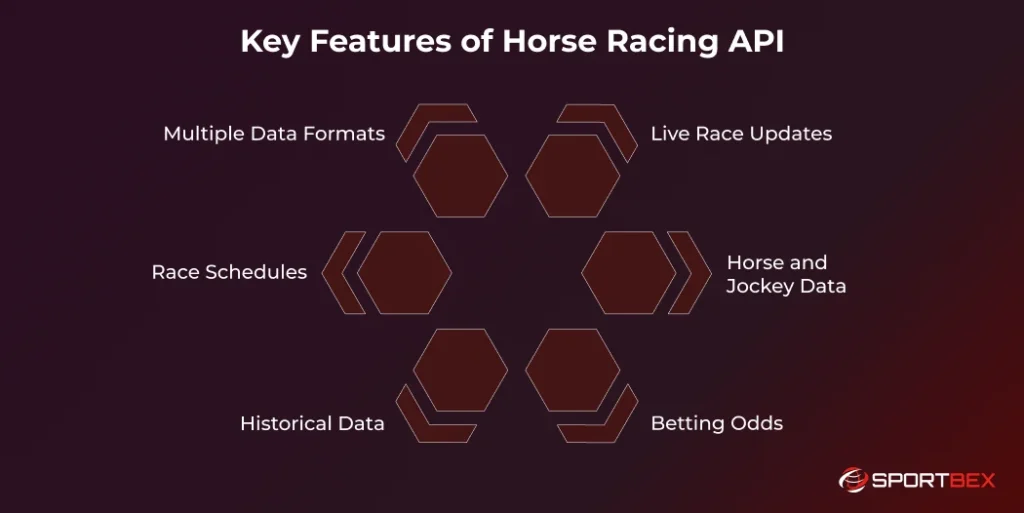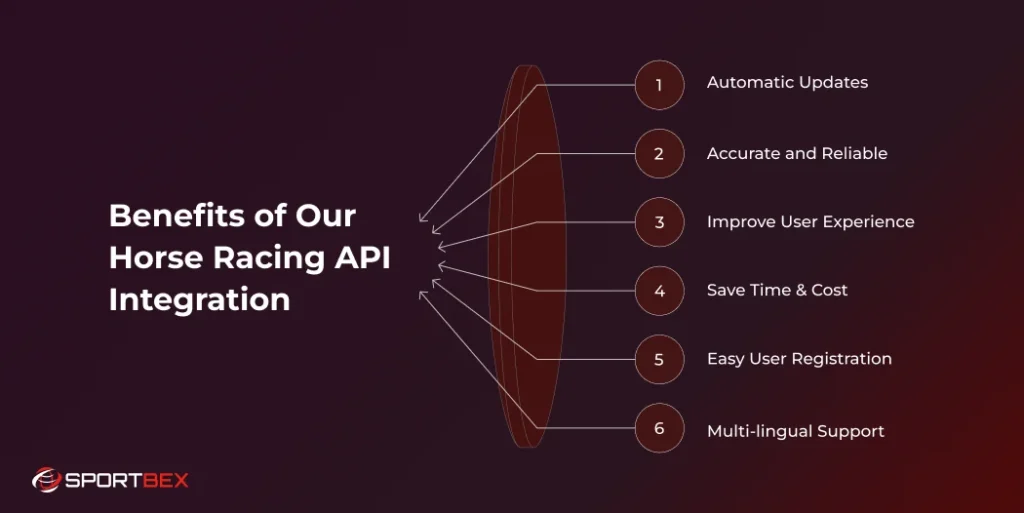Horse racing has always been one of the most thrilling and data-driven sports in the world, captivating fans with its speed, strategy, and excitement. From live race updates to performance analytics and betting insights, horse racing combines passion and precision like no other sport.
In today’s fast-paced digital era, audiences expect instant access to accurate race information. This is where a horse racing API becomes a game-changer. It allows developers, businesses, and content creators to deliver real-time horse racing data, historical stats, and detailed performance metrics seamlessly across websites, apps, and platforms.
This makes it an essential tool for anyone following a Horse Racing API Integration Guide for Beginners to get started quickly and effectively.
A horse racing data API simplifies integration by providing structured and reliable race information that can power live scoreboards, analytics dashboards, or betting apps. For businesses, it opens new opportunities to enhance customer engagement, improve user experience, and build data-rich digital products. Implementing a Horse Racing API Integration ensures your platform delivers accurate, real-time data seamlessly.
What Is a Horse Racing API?
A Horse Racing API or Application Programming Interface is a powerful tool that gives developers, businesses, and racing enthusiasts direct access to real-time and historical horse racing data. It simplifies how platforms collect, manage, and display essential racing information such as live race results, betting odds, and performance statistics.
With a horse racing API, you can easily access details like race schedules, results, horse racing odds API data, horse profiles, jockey information, trainer records, historical performance insights, and a Horse Racing Leaderboard to track top performers.
Whether you’re building a betting app, analytics platform, or sports website, API horse racing integration ensures you deliver accurate and real-time data to keep your users informed and engaged.
Key Features of Horse Racing API

Before integrating a horse racing API into your platform, it’s important to understand the core features and capabilities these APIs offer. Here’s a detailed breakdown:
Live Race Updates
Deliver real-time race updates as events unfold, giving users instant access to race positions, outcomes, and every thrilling moment.
Whether it’s tracking live standings or highlighting dramatic finishes, this feature ensures users stay engaged and never miss a beat.
Perfect for sports platforms or engagement-driven apps looking to enhance user experience and keep audiences connected to the action.
Horse and Jockey Data
Access detailed profiles of horses, jockeys, and their track records to make smarter decisions. These profiles include past performances, win percentages, training histories, and even track-specific preferences, all easily accessible through a Horse Racing API Integration for seamless data management.
Gain insights into jockey strategies, horse stamina, and performance in similar races, providing a comprehensive view of every competitor.
Betting Odds
Stay competitive with live betting odds, delivered in real time to users for informed wagering decisions. These APIs provide continuous updates as odds change, keeping platforms accurate and reliable.
Whether managing a sports betting site or enhancing user engagement, a horse racing odds API ensures users receive timely, precise data and a superior betting experience.
Historical Data
Analyze historical racing data to uncover patterns, strengths, weaknesses, and opportunities for improvement. By studying past races, platforms can create more accurate predictions, track performance trends, and provide users with deeper insights. Historical data is invaluable for analytics, reporting, and predictive tools.
Race Schedules
Keep users informed with detailed race schedules, including what’s happening, when, and where. Clear schedules help audiences plan, stay excited, and remain connected to upcoming events. This feature boosts engagement and ensures users never miss a race.
Multiple Data Formats
Most APIs support flexible formats, such as JSON and XML, making integration convenient for developers across various platforms.
This flexibility allows data to be extracted, managed, and displayed seamlessly on websites, mobile apps, or other systems. Supporting multiple formats ensures smooth communication and reliable performance across all technologies, making Horse Racing API Integration simple and efficient.
Everything You Need for Horse Racing
Access live results, racecards, betting odds, and historical data with one API.
Benefits of Our Horse Racing API Integration

Before starting Horse Racing API Integration on your platform, it’s important to understand the core features and capabilities these APIs offer. Here’s a detailed breakdown:
Automatic Updates
APIs handle real-time updates, ensuring your platform always provides the latest and most accurate information to users. This eliminates delays and outdated data, removing the need for tedious manual entry and making Horse Racing API Integration seamless and efficient.
With automatic updates from a horse racing result, you can focus on delivering seamless, up-to-date experiences that keep your audience engaged. Your users will always stay informed with the most current race information.
Accurate and Reliable
APIs are built for accuracy, pulling data directly from official and reliable sources. This ensures that every piece of information is up-to-date and precise, giving users confidence in your platform.
By leveraging a horse racing API, you provide a trustworthy experience that keeps your platform credible and dependable. Users can rely on your data for consistent and accurate insights every time.
Improve User Experience
From live odds and detailed stats to real-time updates, a horse racing API enhances your platform by delivering the data your audience wants most. Integrating these tools creates a richer, more engaging user experience that keeps visitors informed and entertained.
This seamless, dynamic experience not only meets user expectations but also encourages repeat visits, building loyalty and boosting your platform’s success. Your users will keep coming back for accurate, up-to-date racing insights.
Save Time and Costs
Development teams save time and resources by using a horse racing API, which provides ready-made, structured data without the need to build it from scratch. This allows developers to focus on creating innovative features and enhancing user experience instead of spending hours on backend processes like data modeling or integration.
By leveraging APIs, teams can speed up project timelines, reduce costs, and maintain a more efficient workflow. Your development process becomes faster, smarter, and more cost-effective.
Scalable
A horse racing API grows with your platform, handling everything from hundreds to millions of users without compromising performance. It adapts to increased traffic, manages higher demands, and supports your platform as it evolves.
This ensures your users always enjoy a smooth, reliable experience. Your platform can scale effortlessly as your audience expands.
Step-by-Step Guide to Integrate a Horse Racing API
It’s time to get started and bring a horse racing API to life on your platform. Follow these steps for a smooth and successful Horse Racing API Integration.
Step 1: Get Access
Start by researching and choosing an API provider that best fits your specific needs, considering factors like functionality, reliability, and pricing. Once you’ve identified the right provider, create an account on their platform and carefully review the available service plans.
Step 2: Read the Documentation
Every API comes with developer documentation that provides detailed instructions on how to implement its features. This documentation typically includes information on the available endpoints, methods, parameters, authentication requirements, and example requests and responses.
Step 3: Set Up Your Platform
Ensure your platform is fully equipped to handle API integration by carefully assessing its infrastructure and capabilities. Start by identifying where the data will reside, such as a database, and ensure it is scalable and secure enough to manage incoming data effectively.
Step 4: Make API Requests
Using your provider’s documentation, initiate API requests to fetch the data you need for your application or analysis. This involves understanding the API endpoints, authentication requirements, and request parameters provided in the documentation, including those for a Horse Racing Odds Tracker to monitor live betting odds effectively.
Step 5: Integrate and Code
Leverage the API responses effectively by integrating them at key UI/UX touchpoints where they can provide the most value. This includes areas such as dashboards for real-time data visualization, interactive widgets for enhanced functionality, and timely notifications to keep users informed.
Step 6: Display Data
Optimize how the retrieved data is displayed on your platform to create a seamless user experience. Ensure it’s visually appealing, well-organized, and intuitive for end-users to navigate. This is particularly important for dynamic items like live odds or race results, where clarity and real-time updates are critical.
Step 7: Test and Monitor
Before going live, validate the integration through rigorous testing. Monitor the API connection over time to ensure consistent data delivery. You’ve successfully implemented a horse racing API! Want to branch out further? Consider complementing your platform with a Fantasy Sports API for multi-sport support.
Why Choose Sportbex For Horse Racing API Integration?
Sportbex provides a powerful and reliable horse racing API designed to meet the needs of developers, sports platforms, and betting businesses. It delivers real-time race updates, live odds, historical data, and detailed profiles of horses, jockeys, and trainers, making Horse Racing API Integration seamless and efficient for any platform.
With support for multiple data formats, scalable performance, and easy integration, one of the best horse racing data providers ensures your platform stays accurate, engaging, and responsive.
By leveraging Sportbex, you can enhance user experience, deliver timely insights, and provide data-driven features that keep your audience informed, entertained, and coming back for more.
Conclusion
Horse Racing API Integrating into your platform is a smart way to grow your business and engage horse racing enthusiasts. These APIs provide real-time race updates, live betting odds, and detailed horse and jockey information, creating an exciting and interactive experience for your users.
Whether you’re launching a new platform or enhancing an existing one, a Horse Racing API ensures your data is accurate, up-to-date, and reliable. Features like live race tracking, performance stats, historical insights, and horse racing betting data keep fans informed, engaged, and coming back for more.
Build Your Premier Racing Platform
Get the fast, reliable horse racing data you need to launch your platform.
Frequently Asked Questions
If you're new to development or data integration, the best horse racing API for beginners is one that offers easy-to-use documentation, responsive support, and real-time racing data.
Yes, you can! A horse racing API is perfect for betting platforms that want to offer live race odds, results, and event schedules. It helps enhance the user experience by providing real-time betting data, increasing engagement, and building trust with your users.
To ensure the data from a horse racing API is accurate, choose a provider that sources data from trusted racing authorities and offers real-time updates. Look for APIs that offer uptime guarantees, frequent refresh rates, and developer support to monitor and maintain data quality.
Not necessarily. The cost of integrating a horse racing API depends on the provider and your usage needs. Many APIs offer affordable starter plans for small businesses or trial versions so you can test before investing.
Yes, some advanced sports APIs—including those by Sportbex—offer multi-sport data coverage. This means you can use a single integration to access horse racing, football, tennis, and other sports data through one API.
Recent Blog
What Makes the Cricket Exchange API Valuable for Operators?
November 19, 2025
 9 min
9 min
The Role of Real-Time Data APIs in Horse Racing Prediction
November 19, 2025
 9 min
9 min







